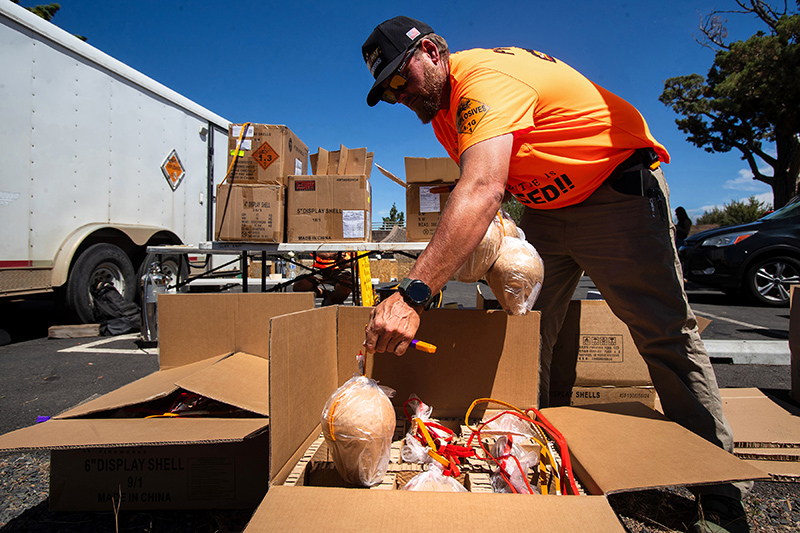For former Blackhawk, the fight against the NHL continues
Published 12:00 am Thursday, November 15, 2018

- Daniel Carcillo, left, excercises at his training facility in Chicago on July 25. Carcillo said he would not accept the deal between the NHL and several hundred retired hockey players who accused the league of hiding the dangers of repeated hits to the head. (Whitten Sabbatini/The New York Times)
CHICAGO — Daniel Carcillo was known as Car Bomb during his National Hockey League career because he played — and lived — with reckless abandon.
In nine seasons with five NHL teams, he accumulated nine suspensions, about 100 fights, 1,233 penalty minutes and myriad fines. He won two Stanley Cups with the Chicago Blackhawks.
He also had seven diagnosed concussions, according to his doctor.
He seemed to be more of a cautionary tale than a change agent. He has become one of the loudest critics of the NHL and the face of the lawsuits brought by former players against the league. They contend the NHL knowingly withheld information about the dangers of hockey-related brain injuries, actively promoted fighting and failed to assist players in the transition from the ice to everyday living.
Even with a settlement in the litigation, announced Monday, Carcillo is not backing down.
He said he would vote against the $18.9 million deal. Nearly $7 million would be distributed to 318 settling plaintiffs, which amounts to roughly $22,000 per player and up to $75,000 to cover medical treatment.
Carcillo said he expected 80 percent to 90 percent of the players named in the lawsuits to accept what the league was offering.
Under the agreement, the NHL does not acknowledge liability for the players’ claims, which angers Carcillo. In a statement issued by the league and the lawyers for retired players, the settlement was called “fair and reasonable.” The league can terminate the deal if all 318 former players do not participate.
Carcillo, however, wants a chance to state his case in court. He has nothing against the players who will accept the settlement, but said, “It’s not for me,” considering how much he gave to the NHL during his career.
“I’m going to fight,” Carcillo said. “I’m going to fight until the end. It’s not acceptable. Not in the slightest.”
His stance is not surprising to those who have followed him on Twitter or in interviews this year. His message is often seasoned with expletives, and his bluntness has drawn attention and criticism.
“When I say the NHL is killing human beings, they’re killing human beings,” Carcillo said.
Compared with former football players, far fewer ex-players in hockey have been willing to take on their league over this issue.
After Carcillo filed his lawsuit in June and appeared in a video for The Players’ Tribune detailing his post-concussion symptoms and treatment, friends turned on him. Some prefer not to talk publicly about him or his efforts. Substantial appearance fees dried up for Carcillo. His business running a training facility for young players went south. Unlike Hall of Famers Eric Lindros and Ken Dryden, who are outspoken critics of hockey’s handling of head injuries but who are still held in high regard, Carcillo has not been invited to speak at high-profile engagements.
Carcillo acknowledged that his reputation from his playing career did not do him any favors. Still, it has not stopped him from going full speed with his mission of seeking better treatment and more education for former players, even if that means alienating other activists.
“Alone doesn’t mean lonely,” he said. “I like doing my own thing.”
To assume this role, Carcillo first had to address his own history of head injuries. Frederick Carrick, considered the top chiropractic neurologist in the United States, placed Carcillo’s brain trauma in the top 10 percent of the worst cases he has seen.
Carcillo suffered the last of his seven concussions in March 2015. By then, he was mentally and spiritually empty. He had appeared in only 39 games for the Blackhawks that season and served a six-game suspension.
The unexpected death of Steve Montador, a close friend of his and a former Chicago teammate, in February 2015 had prompted Carcillo to consider his own mortality, as had the deaths of his grandparents. Carcillo’s first child, Austin, was born three months before Montador died.
Montador, 35 at the time of his death, was found to have severe chronic traumatic encephalopathy, known as CTE, a neurodegenerative brain disorder linked to repeated hits to the head that has become a growing concern among retired NFL and NHL players.
Carcillo did not appear in another game; Chicago went on to win its second Stanley Cup in three years. Before the start of the 2015-16 season, Carcillo retired at age 30. The dark days were just beginning.
Off the ice, he struggled to keep his emotions in check. Friends found him irritable and unbearable. The smallest things set him off. Other symptoms — light sensitivity, bouts with anger and suicidal ideations — increasingly dominated his daily life.
Andrew Dennis, Carcillo’s closest friend since their small-town childhood in King City, Ontario, felt uncomfortable around Carcillo.
“He was never in a good place,” Dennis said.
At one point, Dennis said, Carcillo told him the only thing keeping him alive was his son, who was 15 months old at the time.
Carcillo’s wife, Ela, said: “One minute everyone is crying, the next minute, everyone is happy. It didn’t stop — it’s still going on.”
Last spring, Carcillo decided to see Carrick, the chiropractic neurologist. They first met during the NHL lockout in 2012, at Montador’s suggestion. Carcillo said he had fought Montador on it for weeks.
A five-day visit with Carrick and a subsequent five days of treatments at the Plasticity Brain Centers in Orlando, Florida, cost Carcillo $1,500 per day, but they helped him deal with his symptoms. Without the treatment, Carcillo said, he was dying a slow death. Because of it, he will now continue to seek help for his own sake and for that of his family.
Over the summer, Carcillo was mourning again, after the drowning death of Ray Emery, a former Blackhawks teammate. In the past, Carcillo would have self-medicated with alcohol, opioids or marijuana. This time, to deal with his grief, he cleared trees, brush and rosebushes from the 5 acres where he is making a new home for his family.
Carcillo feels healthy enough to pursue his campaign to make hockey safer and to hold the NHL and its commissioner, Gary Bettman, accountable.
“It’s pretty obvious that the man he is — which is pretty darn beautiful in terms of what he’s doing and able to do — was always there, but he couldn’t express it when you injure your head so much,” said Carrick, who spoke to The New York Times with Carcillo’s permission.
Carcillo’s Chapter 5 Foundation assists and educates former players moving toward retirement.
Until recently, he worked with high school-age players in a training facility he ran at the Blackhawks’ practice rink, teaching the importance of seeking proper treatment for head injuries. He also provides former NHL players with information about brain injuries.
Carcillo believes the NHL, its officials and the players’ union are throwing former players “to the wolves.” He wants the league to have better facilities and doctors for the diagnosis and treatment of brain injuries.
Carcillo sees it as protecting former players, the same way he protected star teammates during his playing days. But his aggressive public-awareness campaign has its share of critics.
“I think some of his tactics are a little off, or he could be doing it in a little more positive way,” former Blackhawks star Jeremy Roenick, an NBC analyst, told The Chicago Sun-Times in July.
Dave Bolland, a former teammate, admitted he was taken aback by some of Carcillo’s social media posts, which prompted him to call Carcillo to ask if everything was OK. Carcillo insisted he was fine.
“His ways are a little bit different,” Bolland said. “He’s on Twitter and he’s letting everyone know that there’s something wrong and that something needs to be done. He’s doing this and he’s doing this full force.
“Sometimes, I do worry about him.”








